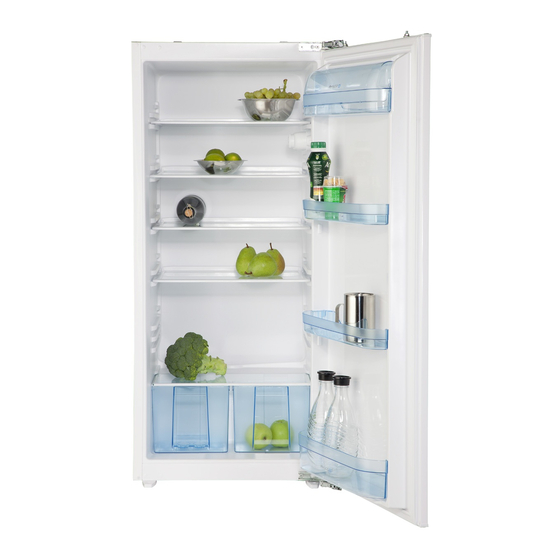
Table of Contents
Advertisement
Advertisement
Table of Contents

Summary of Contents for Philco PTL 1211 BI
- Page 1 REFRIGERATOR USER'S MANUAL PTL 1211 BI...
- Page 2 Dear customer, Thank you for buying a PHILCO brand product. So that your appliance serves you well, please read all the instructions in this user's manual.
-
Page 3: Table Of Contents
CONTENTS PART 1: BEFORE PUTTING INTO OPERATION ....................2 • Safety notices ....................................2 • Safety instructions for gas R600a ..............................4 PART 2: DESCRIPTION OF THE DEVICE ......................5 PART 3: INSTALLATION ............................ 6 • Transport and unpacking ................................6 • Placement ......................................7 •... -
Page 4: Part 1: Before Putting Into Operation
PART 1: BEFORE PUTTING INTO OPERATION Safety notice Symbols: General advice for the optimal operation of the appliance General dangers Hot surfaces Before you put the appliance into operation • Carefully study the user's manual and installation instructions before installing and using the appliance! This user's manual includes important information regarding the installation, operation and maintenance of the appliance. - Page 5 Do not place food inside the refrigerator containing fl ammable propulsion gases (e.g. sprays) and no explosives, contaminants or volatile substances. There is a danger of explosion! • Store liquor only with a fi rmly tightened cap and in a vertical position. •...
-
Page 6: Safety Instructions For Gas R600A
Technical safety The appliance contains a cooling gas, ISOBUTHAN (R600a). Only transport or move the appliance with the utmost care, prevent excessive impacts and shaking to prevent damaging the appliance. If the cooling circuit becomes damaged and the cooling gas may be escaping, there is a risk of an explosion, which may be ignited by a spark or fl ame. -
Page 7: Part 2: Description Of The Device
PART 2: DESCRIPTION OF DEVICE Refrigerator shelves Egg tray Fruit and vegetable compartment cover Cheese and butter shelf Fruit and vegetable compartment Cheese and butter shelf cover Feet for levelling the appliance 10. Light switch Bottle shelf 11. Thermostat Middle shelf NOTE: The picture is for illustration purposes only, some parts may diff er from the fi nal appliance due to improvements made to the appliance during its production. -
Page 8: Part 3: Installation
PART 3: INSTALLATION TRANSPORT AND UNPACKING If the appliance is transported in a horizontal position the oil from the compressor may leak into the cooling circuit. For this reason, allow the appliance to rest in a vertical position for 12 hours before turning it on, so that the oil fl ows back into the compressor. -
Page 9: Placement
PLACEMENT The location for the placement of the appliance must meet the requirements in the paragraph "Operating conditions" and must have a stable fl oor with a load bearing capacity corresponding to the weight of the appliance. This appliance is designed to be built-in. Furthermore you must maintain distances and dimensions of the appliance, so that correct operation is ensured: Top part at least 20 cm;... -
Page 10: Cleaning Before Use
Never cover the ventilation grill. Pull out the power plug by pulling on the plug itself, never pull on the cord when disconnecting the appliance. Before turning on the appliance allow it to stand in its fi nal location for 12 hours, the coolant circuit will stabilise in this way and no operating problems will occur. -
Page 11: Part 4: Setting The Temperature
PART 4: SETTING THE TEMPERATURE Set the temperature in the refrigerator using the temperature control knob. The thermostat control module is connected to the compressor. Turn the temperature control knob upwards or downwards and set the temperature inside the refrigerator. Temperature set to the value "1" is the warmest, and the temperature set to "5" is the coldest. The value "0"... -
Page 12: Part 6: Arrangement Of Food
PART 6: ARRANGEMENT OF FOOD Food products, which are susceptible to the absorption of odours or that release odours must always be stored in closed boxes or in appropriate packaging. Fruit, vegetables and salad products can be stored unpacked in the vegetable drawers. ... -
Page 13: Part 7: Regular Maintenance
PART 7: REGULAR MAINTENANCE Cleaning the refrigerator Before commencing to clean the refrigerator disconnect it from the power source. Use a clean sponge or a soft cloth and a gentle washing detergent dissolved in warm water. Do not use coarse or abrasive cleaning products. - Page 14 Please be aware: Compressor The compressor is controlled by the thermostat, which is set by the temperature control knob, and turns itself on automatically when temperatures inside the appliance is exceeded and then turns itself off as soon as it again reaches this temperature.
-
Page 15: Part 8: What Should I Do When
PART 8: WHAT SHOULD I DO WHEN... a) The appliance is not working. Please check the following: Is the power plug in good condition and properly plugged into the power socket? Is there electricity fl owing into the power cord? (Check this possibility by connecting a small appliance like a hand mixer or hair fan, etc.) ... -
Page 16: Part 9: Performance Label/Technical Specifications
The rating label with all the technical specifi cations is located on the side of the inside wall or on the rear side of the appliance. Technical specifi cations Model PTL 1211 BI Climatic class Net volume 204 l Operating voltage 220 –... - Page 17 INSTRUCTIONS AND INFORMATION REGARDING THE DISPOSAL OF USED PACKAGING MATERIALS Dispose of packaging material at a public waste disposal site. DISPOSAL OF USED ELECTRICAL AND ELECTRONIC APPLIANCES The meaning of the symbol on the product, its accessory or packaging indicates that this product shall not be treated as household waste.
















Need help?
Do you have a question about the PTL 1211 BI and is the answer not in the manual?
Questions and answers